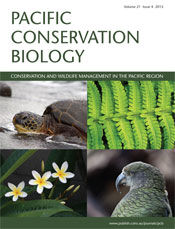
Pacific Conservation Biology
Volume 21 Number 4 2015
PC15022Ignoring the science in failing to conserve a faunal icon – major political, policy and management problems in preventing the extinction of Leadbeater’s possum
Leadbeater’s possum is one of the most well studied critically endangered species worldwide. It is at risk from the effects of industrial logging, recurrent wildfire, and interactions between both. Current forest management is driving the species rapidly toward extinction and a large ecological reserve is needed to secure remaining populations.
PC15042The need for a comprehensive reassessment of the Regional Forest Agreements in Australia
Regional Forest Agreements (RFAs) underpin management of Australia’s commercial native forests. Some advocates are urging a rapid approval of RFAs for another 20 years with no review. We argue RFAs must be comprehensively reappraised to accommodate new information on threats and values of forests, and employ proper resource and financial accounting.
PC14925Movement and mortality of Australian pelicans (Pelecanus conspicillatus) banded at inland and coastal breeding sites in South Australia
Pelicans leg-banded in at inland and coastal sites in South Australia showed that individual pelicans move up to 3200 km and live for up to 15 years. Pelicans were mostly recovered in the Murray-Darling drainage, where they are declining, and one sixth of pelican deaths were human-induced. There is limited exchange between inland and coastal pelican populations.
PC15032A diagnostic framework for biodiversity conservation institutions
More effective conservation approaches are required to stem biodiversity loss. Institutions can both help and hinder such efforts, but practical tools are needed to more precisely identify where changes are needed. A framework considering both the salient aspects of biodiversity conservation and the practical constraints on organisations provides such a tool.
PC15021The distribution and conservation status of Carpentarian grasswrens (Amytornis dorotheae), with reference to prevailing fire patterns
Carpentarian grasswrens are small birds that live in flammable spinifex habitats in central parts of northern Australia. Previous research has suggested that populations have declined in the Northern Territory. We present an analysis of survey data from all populations that factors in the problem of detecting this shy species. Our results corroborate earlier research, suggesting widespread decline. Frequent, large scale fires are probably the main cause.
PC15016Comparison of soils and plants on the active and relic parts of a recolonised burrowing bettong (Bettongia lesueur) warren
Nutrient enrichment, probably from the urine and faeces of burrowing bettongs, is hypothesised to have resulted in improved plant productivity on the active parts of a recolonised warren at the patch scale. Since this study, at least 16 relic warrens have been recolonised at the study site and a replicated study is recommended to investigate the hypotheses raised.
PC15015An estimate of above-ground carbon stock in tropical rainforest on Manus Island, Papua New Guinea
Carbon stock of stems ≥ 5 cm diameter at breast height in forests of Manus Island, Papua New Guinea were quantified in a model-selection framework. The top models described variation in average carbon stock in above-ground biomass solely in terms of forest type: primary hill forest, primary plain forest, and secondary hill forests.
PC15019Capture success of Fijian bats (Pteropodidae) and their evaluation as umbrella species for conservation
We netted Fiji’s plant-visiting bats over 2.5 years in lowland rainforest and cloud forest. We caught 290 bats over 2.5 years, including the rare monkey-faced bat, in one of the largest netting studies of Pacific Island bats. We detail factors influencing capture success, and assess bats as ‘umbrellas’ for protecting a large number of co-occurring species.



